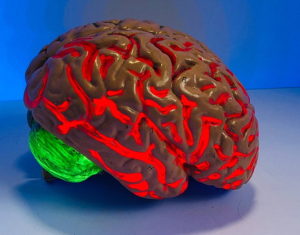An Excerpt from a Patient Who Suffers from Mental Illness
 “Why write a blog about mental illness. Is it an illness? Is it a disease of the mind? Is it an abnormality? Am I normal? Why put myself out there when it will only invite unwanted criticism and name calling. Being known as someone who has depression and anxiety carries a tremendous personal burden, a steep price of added suffering and torment – one extra hill to climb out of. So again you ask, why am I doing this? Because mental illness is just that. It is an illness. Most people need to understand that. And the more people who are aware are able to help. We need a community to band together and stop the shame of depression. Stop the teen suicides. If my story can help in anyway shed light on this illness then I am willing to battle the scars of criticism.
“Why write a blog about mental illness. Is it an illness? Is it a disease of the mind? Is it an abnormality? Am I normal? Why put myself out there when it will only invite unwanted criticism and name calling. Being known as someone who has depression and anxiety carries a tremendous personal burden, a steep price of added suffering and torment – one extra hill to climb out of. So again you ask, why am I doing this? Because mental illness is just that. It is an illness. Most people need to understand that. And the more people who are aware are able to help. We need a community to band together and stop the shame of depression. Stop the teen suicides. If my story can help in anyway shed light on this illness then I am willing to battle the scars of criticism.
Prejudice, stigmas, and bigotry take the path of least resistance – they are free of the chains of clear thought, consideration of the differences of others and plain fact. They are free to spread and indiscriminately injure and wound. They are escaped prisoners that need rounding up. They are the bullies that need to be grabbed by the ear and told. Whether they listen or understand or change their nasty ways remains a mystery to me. I mean, if you’re stuck in a revolving door of fear and ignorance long enough eventually you have to jump out, shake off the dizziness and reorient yourself — perhaps desperate optimism or naive hopefulness on my part. I’m sensitive yet thick when I need to be.
Being brave, open and vulnerable. I am able to with a quiet courage to leave my house every day and endure the mean-spirited off-handed comments from bored and ignorant. So many, including myself live in fear that our dark secret will somehow get out. That someday someone will catch us taking our medication. That the jabs and ribbing will one day become more than we can stand. Courage, bravery and raw endurance occurs daily in utter silence. You are not alone!”
Overview
 We are all aware of the dangers to society when a person whose mental health issues goes undetected, sometimes resulting in tragic and disastrous results. Although there are thousands of people and organizations working to determine what causes people to react this way, there was no indication of this behavior, it is an ongoing and tedious process. And so far, no substantial or specific reason has been confirmed.
We are all aware of the dangers to society when a person whose mental health issues goes undetected, sometimes resulting in tragic and disastrous results. Although there are thousands of people and organizations working to determine what causes people to react this way, there was no indication of this behavior, it is an ongoing and tedious process. And so far, no substantial or specific reason has been confirmed.
Although violence rests in the category of extreme mental illness, most people whose mental health has been affected in one way or another usually suffer from stress, depression and/or addiction to drugs.
In this article, we will not dwell on the specific illnesses that exist, nor will focus on the politics related to mental health issues; indeed, this subject alone fills entire websites. Instead, we will concentrate on the underlying factors regarding mental illnesses and simply bring them to light here.
Stressful Environments and Mental Health Disorder
 One conclusion regarding mental health issues is that there is a direct connection to today’s contemporary world and the stresses that are associated with it. Just about every one of us has been subjected to some type of stress during our lifetime, but it is how we deal with it and how we proceed that determines what will happen next.
One conclusion regarding mental health issues is that there is a direct connection to today’s contemporary world and the stresses that are associated with it. Just about every one of us has been subjected to some type of stress during our lifetime, but it is how we deal with it and how we proceed that determines what will happen next.
For many, these anxiety-prone situations can lead to frustration, anger, depression and/or melancholia. When we face such situations, it can cause a deterioration in our daily performance and functioning, as well as the possibility of developing more serious mental health issues.
What is Mental Health?
According to The World Health Organization (WHO), good physical health starts with good mental health. It is the most basic element for our holistic well being.
Good mental health provides us with the ability to cope effectively with the stressors of our lives. When we are healthy, we are able to use our full potential, perform productively and contribute effectively to our community.
Statistics reveal that over 450 million people worldwide are negatively affected in their cognitive well-being at one time or another and one in six adults and one in ten children suffer from serious mental health issues.
Causes of Poor Mental Health
There is a wide range of factors that can cause mental health deterioration: genetic factors, prolonged stress, physical illness and traumatic events. Political and social environments also play a role in influencing our mental health.
Social Environment
Suicide is not uncommon among American teenagers, especially girls. Many families have to cope with teens that resort to overdosing on prescription or even over the counter drugs. But what caused them to overdose in the first place? According to a multitude of case histories, young girls can resort to attempting to ‘kill themselves’ because they broke up or simply had an argument with their boyfriend. Whether it is just to achieve attention, get back at the boyfriend or something else, most of these young teens survive. As they mature, this precarious mental state subsidies and they go on to live normal lives like it never happened.
In one case history, a 15-year-old girl grabbed Tylenol and overdosed on them. She wasn’t able to feel her hands or feet and the boyfriend immediately called her parents. The girl was immediately taken to the hospital. Doctors determined that she will need to sleep it off, but if she happened to take just a little more, she could have had more serious complications, including a damaged liver.
Fortunately, she came out of it alright, but a prerequisite from being released from the hospital was to see the hospital psychiatrist. There, she was ‘set straight’ regarding how close she was to ruining her internal organs, as well as being admitted to a psychiatric ward. The girl is fine now is in college. So in this particular case, a sudden scare into reality was all that was needed.
Other teens are not that lucky. Some are subjected to a more serious mental stain and perceive their issues as ‘not worth living’. Bullying, simply because they are different in some way, can become a motivation towards suicide and unfortunately, in these cases, some do not make it through.
Depression and anxiety are the most common health disorders that one might face if he/she are not able to cope with an anxiety that may be affecting their eternal well being.
One of the major reasons that mental health has become a concern is lack of awareness, inability to have effective coping mechanisms and the stigma attached in some societies to get help and go to a professional mental health counselor. Not looking for the assistance that you may need out of fear of being isolated, bullied or not being able to get jobs.
According to the Mental Health Foundation, there are two major categories of mental disorders: neurosis and psychosis. Few indicators of poor mental health are feeling lethargic, withdrawing from society; drop in your productivity and performance, feeling like crying all the time and weight gain or loss.
Benefits of Maintaining Mental Health
Living with mental health disorders affects your relationship, studies, parenting skills and work. It is important in order for your own well being and others that you take the support of mental health counselors.
Your emotional well being improves your quality of life and gives you peace of mind and the ability to live life to the fullest while coping with stressful factors effectively.
Well balanced mental health will help you to cope with stress and be able to maintain healthy relationships, make sound life decisions, use your potential to the maximum level and maintain both your mental and physical health.
Those of you who maintain your mental health and take the support of counselors have to spend less money on their health. Poor mental health causes many physical ailments that increase your frequency of visiting doctors and taking medication. Similarly, when you have poor mental health you will take more medications and therapy sessions. Both will increase the cost of medical bills but after you receive proper mental health counseling or therapy you will be more mentally fit and will not have the need to visit the doctor or take medication. This reduces the cost of your medical bills.
Good mental health prevents poor physical healing and dangerous habits such as smoking or unhealthy eating behavior.
Many research studies have provided evidence that for those of you who took proper mental health care and support of a counselor the number of medical visits decreased.
Good mental health increases your energy level and provides you with effective coping mechanisms for a stressful environment. It helps you deal with a difficult situation and improves your performance and efficiency at work by utilizing your potential to the maximum level.
About Mental Health Counseling
 A mental health counselor helps you deal with your emotions, provide tools to cope with your stress in a healthy way and deal with mental health disorders or trauma that you may have faced. Mental health counselors work in various avenues such as school, office, and hospitals.
A mental health counselor helps you deal with your emotions, provide tools to cope with your stress in a healthy way and deal with mental health disorders or trauma that you may have faced. Mental health counselors work in various avenues such as school, office, and hospitals.
These counselors use various approaches for providing mental health support. Such as cognitive analytical therapy, dialectical behavioral therapy, crisis treatment, group or life-changing counseling and substance abuse counseling.
Importance of Counseling
Mental health counselors help you deal with your emotions, daily life stressors, and experiences. It helps you set goals, design an action plan for those goals and gain further insight.
According to the American Counseling Association counseling empowers you to achieve mental well being, education, career goals and mental health.
They are highly trained professionals that help you live a more happy and productive life. The school counselor helps you deal with your academic and other school-related concerns and daily life stressors related to your school and studies.
The career counselor’s help you improve your productivity and deal with work-related stressors or career-related identity crises. They help you find the best career path for you and deal with other employment-related concerns.
Mental health counselors play the most significant role by treating those of you who may be suffering from mental health disorders such as schizophrenia, bipolar disorder, and post-traumatic stress disorder.
A Mental health counselor helps you become productive and efficient and by helping you gain a healthy mental well being they help you become an effective member of your society.
Avoiding treatment through mental health professionals can cause considerable negative social and economic impact on you and your society.
Mental hygiene and counseling
We may take care of our physical health but ignore the importance of staying mentally fit. Dealing with daily life stressors and unexpected extraordinary difficult situations can take a toll on you. By going to a counselor you can vent out your feeling and emotions, gain better insight and be able to cope with your difficult experiences in an effective and healthy manner. Thus, keeping your mind and body healthy and becoming an effective member of your society.









